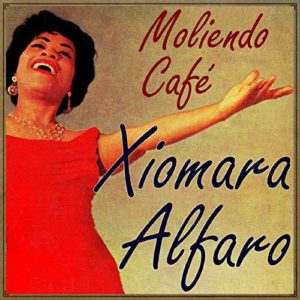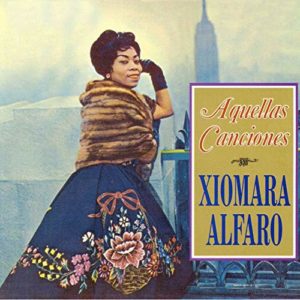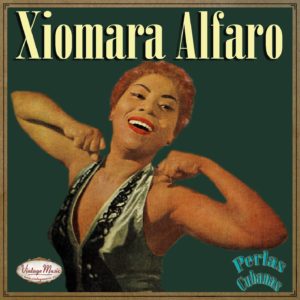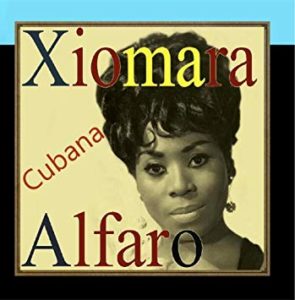 XIOMARA ALFARO, EXITOSA CANTANTE CUBANA CON UNA VOZ DE SOPRANO ÚNICA. VIDEOS
XIOMARA ALFARO, EXITOSA CANTANTE CUBANA CON UNA VOZ DE SOPRANO ÚNICA. VIDEOS
Xiomara Alfaro fue una vocalista de gran éxito que nació el 11 de mayo de 1930 en La Habana, Cuba, conocida por su voz de soprano coloratura aguda, comenzó a cantar de niña en reuniones familiares y eventos comunitarios en su vecindario de Marianao. Como era habitual en ese momento, los jóvenes cantantes que deseen iniciar carreras profesionales se unirían a concursos de talentos que se realizarán en varias estaciones de radio en La Habana. La joven Xiomara fue la ganadora de uno de esos concursos en Radio Suaritos y se convirtió en una habitual de sus transmisiones. El compositor y pianista Obdulio Morales la escuchó cantar en la radio y quedó tan impresionado que la invitó a unirse al elenco de su revista musical “Batamú”, que se estrenó en el Teatro Martí en 1951.
https://youtu.be/20wj3xS-6qg
Xiomara canta “Siboney”.
Después de su éxito en ese programa, la señorita Alfaro tuvo una gran demanda por parte de los directores y productores de entretenimiento en los muchos cabarets, clubes nocturnos y teatros que florecían en La Habana en ese momento. Actuando en el famoso Tropicana, llamó la atención de la bailarina y coreógrafa estadounidense Katherine Dunham, quien le ofreció a Xiomara un contrato con su compañía. Con la compañía de Dunham, el vocalista cubano tuvo la oportunidad de viajar extensamente por Alemania, Suiza, Grecia e Italia. Durante su residencia en Roma, el grupo de Dunham, incluido Xiomara, apareció en la película “Mambo” (1954) dirigida por Robert Rossen.
Después de esto, la cantante aceptó contratos en solitario que la llevaron a varios países sudamericanos. A su regreso a Cuba, fue aclamada por los medios como una verdadera superestrella y pronto fue firmada por el sello discográfico RCA Victor. Su álbum “Siboney” fue un éxito instantáneo tanto en Cuba como en el extranjero. La canción “Siboney” del compositor Ernesto Lecuona se convirtió en su canción principal, mientras que otras canciones como “Luna Rossa” y “Anema e Core” hicieron desfiles de radio durante semanas. Como exitosa artista de grabación, la señorita Alfaro continuó cautivando al público donde sea que cantara, especialmente en la televisión donde tenía una presencia constante en todos los programas de variedades más importantes. Xiomara Alfaro se había convertido en un nombre familiar no solo en su país sino en todo el continente americano.
Xiomara canta “Moliendo Cafe”.
Con la llegada de la revolución cubana en 1959, llegó una dictadura comunista despiadada que tenía como objetivo controlar todos los aspectos de la vida cubana, incluidas las artes escénicas. A la señorita Alfaro no le agradaron estos eventos y, como muchos otros artistas cubanos de su estatura, huyeron del país en 1960 para nunca volver. Como era conocida internacionalmente, continuó su carrera sin problemas.
Xiomara recorrió Europa una vez más y tuvo una larga residencia en París. En Londres, le pidieron que cantara en la despedida de soltera de la princesa Margarita y fue invitada de la familia real. Luego, realizó una gira por América del Sur y Central donde era una ídolo, y continuó grabando. Aunque tenía una voz extraordinaria y podría haber cantado ópera, prefería la música popular, especialmente los boleros románticos. Su repertorio siempre incluía lo mejor del cancionero de América Latina, así como los estándares franceses e italianos. Los revisores siempre notaron que la señorita Alfaro había creado un estilo de canto nuevo y original en la música popular que nunca podría ser igualado por otros cantantes.
Xiomara canta “Angelitos Negros”.
Durante los conciertos en Panamá, conoció y se casó con el músico Rafael Benítez, quien se convirtió en su director musical tanto en conciertos como en discos. La pareja se estableció primero en Nueva York y luego en Florida, y su unión duró más de medio siglo. Los años de exilio de Xiomara fueron muy fructíferos, actuando constantemente en los lugares más prestigiosos de los Estados Unidos, Canadá, México, América Central y del Sur, con giras ocasionales en Europa y Medio Oriente.
Sin embargo, ella siempre echó de menos su tierra natal y se entristeció hasta el final de su vida por el hecho de que nunca vería el amanecer de la libertad en la desafortunada isla. A los 80 años, la talentosa y trabajadora Xiomara Alfaro se retiró debido a problemas de salud, pero nunca perdió su entusiasmo y sentido del humor. El final llegó el 24 de junio de 2018 cuando se enfermó gravemente. Ese día, aproximadamente a las 11:00 p.m., la gran cantante cubana murió en silencio de un paro cardiorrespiratorio rodeada de familiares y amigos en su casa de Cape Coral, Florida.
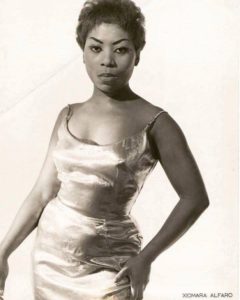 XIOMARA ALFARO, SUCCESSFUL CUBAN SINGER WITH A UNIQUE SOPRANO VOICE. VIDEOS.
XIOMARA ALFARO, SUCCESSFUL CUBAN SINGER WITH A UNIQUE SOPRANO VOICE. VIDEOS.
Xiomara Alfaro was a highly successful vocalist who was born on May 11, 1930, in Havana, Cuba noted for her unique high pitched coloratura soprano voice, she started singing as a child in family reunions and community events in her Marianao neighborhood. As customary at the time, young singers wishing to launch professional careers would join talent contests held at various radio stations in Havana. Young Xiomara was the winner of one such contest at Radio Suaritos becoming a regular of its broadcasts. Composer and pianist Obdulio Morales heard her singing on the radio and was so impressed that he invited her to join the cast of his musical revue “Batamú” which debuted at the Martí Theater in 1951.
After her success in that show, Miss Alfaro was in great demand by entertainment directors and producers in the many cabarets, night clubs and theaters thriving in Havana at the time. Performing at the famous Tropicana, she caught the eyes and ears of the American dancer and choreographer Katherine Dunham who offered Xiomara a contract with her company. With the Dunham troupe, the Cuban vocalist had the opportunity to travel extensively through Germany, Switzerland, Greece, and Italy. During their Rome residency, Dunham’s group including Xiomara were featured in the film “Mambo” (1954) directed by Robert Rossen.
After this, the singer accepted solo contracts that took her to several South American countries. On her return to Cuba, she was hailed by the media as a true superstar and was soon signed by the RCA Victor record label. Her album “Siboney” was an instant success both in Cuba and abroad. The song “Siboney” by composer Ernesto Lecuona became her signature song while other tunes such as “Luna Rossa” and “Anema e Core” made the radio hit parades for weeks. As a successful recording artist, Miss Alfaro continued mesmerizing audiences wherever she sang, especially on television where she had a constant presence in all the top variety shows. Xiomara Alfaro had become a household name not only in her country but throughout the Americas.
With the arrival of the Cuban revolution in 1959, came a ruthless communist dictatorship that aimed to control all aspects of Cuban life including the performing arts. Miss Alfaro was not pleased by these events and, like many other Cuban artists of her stature, fled the country in 1960 never to return. Since she was well known internationally, she continued her career without a hitch.
Xiomara toured Europe once more and had a long residency in Paris. In London, she was asked to sing at the bridal shower of Princess Margaret and was a guest of the Royal Family. Next, she toured South and Central America where she was an idol, and continued recording. Even though she had an extraordinary voice and could have sung opera, she preferred popular music, especially romantic boleros. Her repertoire always included the best of the Latin America songbook as well as French and Italian standards. Reviewers always noted that Miss Alfaro had created a new and original singing style in popular music that could never be matched by other singers.
During concerts in Panama, she met and married musician Rafael Benítez, who became her musical director both in concerts and records. The couple settled first in New York and later in Florida, their union lasting over half a century. Xiomara’s exile years were very fruitful, performing constantly in the most prestigious venues of the United States, Canada, Mexico, Central, and South America, with occasional tours in Europe and the Middle East.
However, she always missed her homeland and was saddened to the end of her life by the fact that she would never see the dawn of freedom rise on the unfortunate island. At age 80, the gifted and hard-working Xiomara Alfaro retired due to health issues but never lost her spunk and sense of humor. The end came on June 24th, 2018 when she became seriously ill. That day, at approximately 11:00 PM, the great Cuban singer died quietly of cardio-respiratory arrest surrounded by family and friends in her home of Cape Coral, Florida.
Agencies/ IMDb/ Mark Martin/ Internet Photos/ YouTube/ Arnoldo Varona/ www.TheCubanHistory.com
THE CUBAN HISTORY, HOLLYWOOD.



